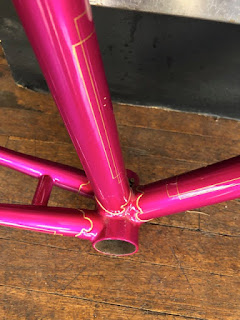I got out for a nice Memorial Day ride this morning. Our weather is sunny and unseasonably warm. I left early while it was still reasonably cool, hoping to beat the heat, but by the mid-point of my ride it must have already been nearing 80 degrees with high humidity.
 |
| I stopped for a photo near this little cottage in the national park. I'm not sure of the history of this place, but it has been vacant for as long as I can remember, and is (I believe) currently owned by the park service. They own a lot of the old houses in the park - some are used as offices, and a few are leased out to various groups, but not this one, apparently. It reminds me a bit of the cottage-style motels that used to dot the highways, but I don't think that's what this was. It's like a tiny duplex, in the midst of what used to be mostly farm land, so I wonder if it might have been lodging for seasonal farm workers for one of the local farms. Who knows? Cute little place, though - and a good spot for a bike photo. |
The other thing I wanted to write about today was that I recently learned of the death of John Forester, whom many consider one of the "founders" of the modern bike advocacy movement, and the riding philosophy generally known as "vehicular cycling." I'm actually a bit late on this, as he died over a month ago on April 14 at age 90.

Forester was born in England in 1929, the son of Cecil Scott "C.S." Forester - author of such noted novels as the
Horatio Hornblower series, and
The African Queen (adapted into a classic film starring Humphrey Bogart and Katherine Hepburn). He moved with his family to California when he was 10 years old, and he would later take on American citizenship. He graduated from Berkely in the 1950s and had a stint in the U.S. Navy. He was a lifelong cyclist.
Living in the Palo Alto area in the 1970s, he famously received a ticket for riding in the street, and refusing to ride in the recently created bike-way. He fought the ordinance that mandated cyclists to use the bike-way and won. Many people cite that action as the beginning of a movement. He would go on to write numerous articles for cycling magazines, and became very involved in the fight against the Consumer Product Safety Commission's (CPSC) safety regulations on bicycles, which he believed were poorly written and conceived - and failed to distinguish adult bicycles from children's toys.
 |
| I have the 6th edition. |
Forester should well be remembered for his book
Effective Cycling which has been through 7 editions since it was first published in the 1970s. Though some people today may argue against some of his methodology, I believe his advice on sharing the road with motor vehicles - with the same rights, and responsibilities as motorists - is generally sound, and it is advice that I have long followed.
He was a controversial character in the bike advocacy movement, frequently ruffling feathers and clashing with other prominent advocates, in part because he was a staunch opponent of bike lanes and bicycle-specific infrastructure. That was a point that many modern advocates clashed with him on, and I'm sure there are some who believe that, if not for Forester, every city in the U.S. would be like Amsterdam. As for myself, I'm
highly skeptical of such claims, and assume them to be grossly exaggerated. Personally, I tend to disagree with "all or nothing" approaches to anything, regardless of which side of an issue people are on, but in order to understand the reasoning behind Forester's stance, it's important to know that in
his experience, and from
his point of view, most bike lanes were poorly designed by people who did not ride or understand the needs of cyclists, and the efforts were typically undertaken NOT to help cyclists, but rather, to restrict them and keep them off the roads. People often described him as "inflexible" - but I think it helps to know where he was coming from.
Whether people agreed or disagreed with him, I think a lot of us owe some gratitude to Forester. Rest in peace, sir.

















































